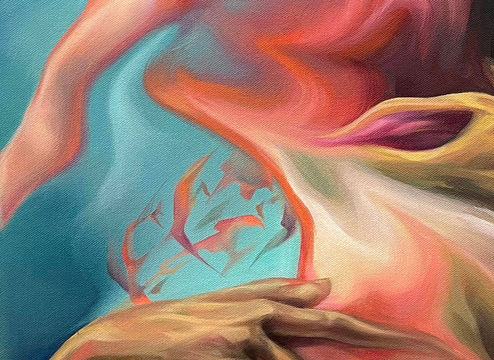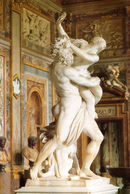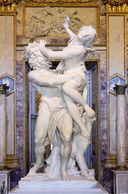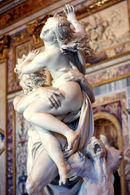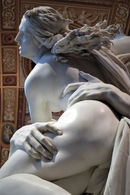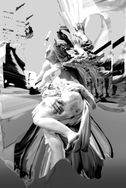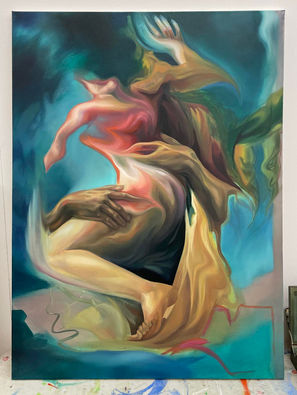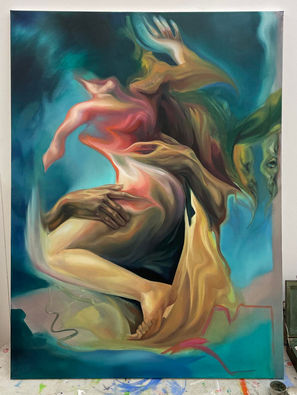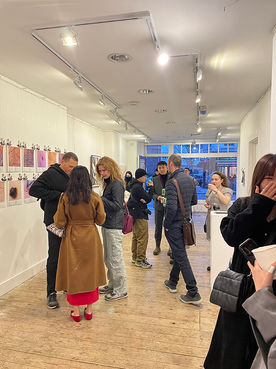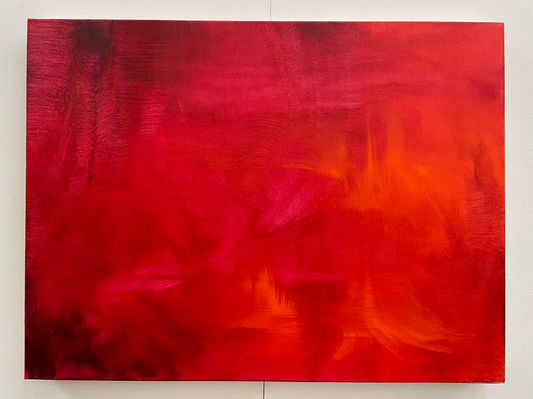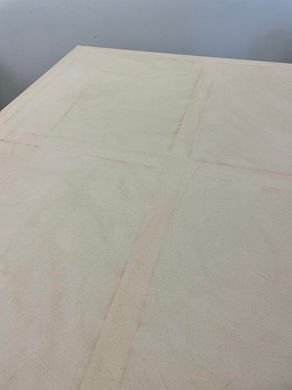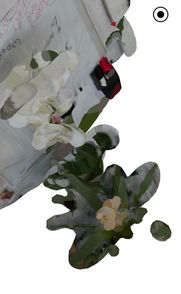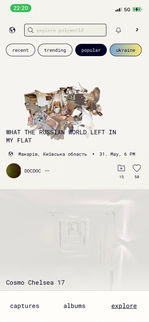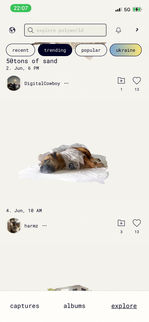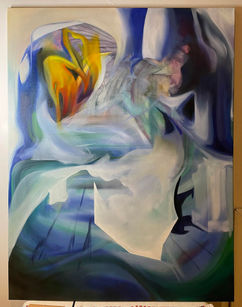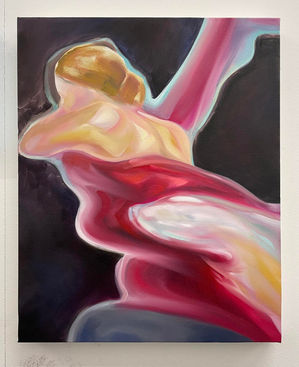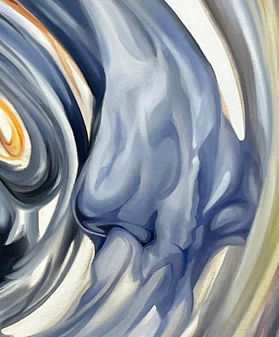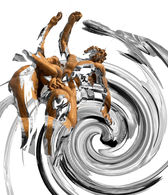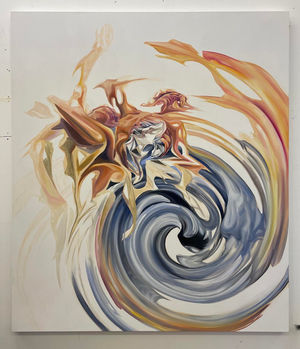For my further artistic practice I would like research the accelerating effect the implementation of digital technology and algorithms has on an individual.
For my further artistic practice I would like research the accelerating effect the implementation of digital technology and algorithms has on an individual.
Artworks and Processes
Artworks and Processes
Artworks and Processes
Artworks and Processes
Here is a heading
Ich bin ein Textabschnit. Klicke hier, um deinen eigenen Text hinzuzufügen und mich zu bearbeiten. Ich bin ein Textabschnitt. Klicke hier, um deinen eigenen Text hinzuzufügen und mich zu bearbeiten.Ich bin ein Textabschnitt. Klicke hier, um deinen eigenen Text hinzuzufügen und mich zu bearbeiten.Ich bin ein Textabschnitt. Ich bin ein Textabschnitt. Klicke hier, um deinen eigenen Text hinzuzufügen und mich zu bearbeiten. Ich bin ein Textabschnitt. Klicke hier, um deinen eigenen Text hinzuzufügen und mich zu bearbeiten.Ich bin ein Textabschnitt. Klicke hier, um deinen eigenen Text hinzuzufügen und mich zu bearbeiten.Ich bin ein Textabschnitt.
Here is a heading
Ich bin ein Textabschnit. Klicke hier, um deinen eigenen Text hinzuzufügen und mich zu bearbeiten. Ich bin ein Textabschnitt. Klicke hier, um deinen eigenen Text hinzuzufügen und mich zu bearbeiten.Ich bin ein Textabschnitt. Klicke hier, um deinen eigenen Text hinzuzufügen und mich zu bearbeiten.Ich bin ein Textabschnitt. Ich bin ein Textabschnitt. Klicke hier, um deinen eigenen Text hinzuzufügen und mich zu bearbeiten. Ich bin ein Textabschnitt. Klicke hier, um deinen eigenen Text hinzuzufügen und mich zu bearbeiten.Ich bin ein Textabschnitt. Klicke hier, um deinen eigenen Text hinzuzufügen und mich zu bearbeiten.Ich bin ein Textabschnitt.
Artworks and Processes 2
Group Crit – Paul Coldwell
20.01.22
-
Research is too broad - narrow it down and go deeper
-
imagine curating an exhibition - who would be the other artists in the show together with your own works / find your family of artists / to whom do I connect?
(while looking at “Where nothing ever happens”)
-
it feels as if the image is just a part fo a bigger composition
-
try to keep the eye of the viewer in that fragment
-
reflect on how the eye is contained in the picture → visit the National Gallery and study the composition of a work for 10 minutes to understand the structure
-
How is a composition constructed?
-
Collage and the collision of worlds
Research
Composition
1-2-1 Tutorial – Anna Bunting-Branch
27.01.22
-
smaller mediations to break down sections
-
Fluidity and the Glitch
-
what is the relationship between the human and the digital
-
visceral sensation
-
make a vision board and record how long everything takes me
-
sense of a relation to certain histories → baroque painting → spiralling motion → turbulence
-
take a closer look at the composition / structure of baroque paintings
Key Concepts
Research
Assessment Feedback – Improvements for Unit 2
10.02.22
Image and Technique
Source Material
Colour Palette
Process
Artist Statement
Critical Reflection
Key Concepts
Connections
New References
-
Sense that you are holding onto painting an image, rather than engaging in a more embodied way with the process of painting
-
Experiment with more indexical marks, collaging imagery (perhaps photos of your own paintings, as well as the 3D scans, or even paintings on paper) could help loosen up your approach
-
Relation between your 3D animations and paintings will be exciting area to explore in Unit 2 / scanning paintings as textures into the 3D programme?
-
Using digital renders as source material → challenge your palette
-
Feels a bit traditional — lacking in that vivid, luminous quality that characterises our experience of the screen (AP Fitzpatrick)
-
Experiment with refining your use of masking (as explored in Fractal)
-
Dense terms here, which would benefit from being unpacked
-
Reflect on each of them further to allow you to edit and refine the vocabulary you use to discuss your practice
-
Some terms that you use can function as both aesthetic and conceptual descriptors, making them particularly fruitful to explore in more depth: Fracture, fractal, glitch, fluidity…
-
Unit 2 will be anchoring yourself to a more refined network of key terms
-
Refinement of your thinking will allow you to move towards making your own contribution to ongoing conversations on these important subjects
-
Immersion in relation to technological experience and to the wave imagery you have been working with → Go deeper in exploring the relation between algorithm and abstraction / the idea of data and/as materiality feels like a rich avenue
-
Develop dialogue with students and tutors from the Computation Arts pathway
Artists
→ Christina Quarles mind-bending layered compositions
→ Richter’s Atlas process
→ Laura Owens
→ Tom Worsfold / current show at Ginny on Frederick (book in advance to see for free)
→ Vivien Zhang
Contexts
→ Legacy Russell on the ‘glitch’ / IMT show and Glitch Feminism
→ Silvia Federici on gender and technology / See ‘Re-enchanting the World’
→ Rindon Johnson at Chisenhale Gallery
Reading Group – Srinivas Surti & Anna Bunting-Branch
18.02.22
Hito Steyerl, The Wretched of the Screen A Thing Like You and Me (p.46-58)
Find my notes → here
Question: How does painting become the object or thing that we participate in/with?
relocate in the world, sense of room space, find themselves in space
purely subjective? how do you make it objective?
Renaissance and the discovery of space and dimensionality in painting /
relocating oneself in a new way and in a new space
Anatomy Mondays – Eleanor Crook
24.01.22 – 28.03.22
Participating in Eleanor Crook's anatomy course was a lot of fun and enriched my imagination a lot. I have always been interested in human anatomy, but up until now only to understand and depict its proportions correctly. I had not dared to look under the skin yet. Thanks to this new approach through Eleanor, my view of the human body has changed and the way I paint it has become more refined.


sketches of a dangling skeleton and its skull
coloured pencil drawing of the upper skull bone from side view

pencil sketch of the male torso of a sculpture with "ideal" proportions (pelvis here too small)




quick study of muscle distribution in a male body
Session 1 – overview of the bones in the upper body
Book recommendation:
S. Simblet's medical book
celebration of the human figure by making a statue
the ancient greeks – methods and ideas of idealized bodies
changes in proportions with the Renaissance
power beyond deconstructive effects
bones of different bodies mixed to achieve a large and "ideal" proportion
Michelangelo
Sketches and reflections
on muscle cords and muscle fibers
How can the body interact with or be confronted with the work being viewed? How does my painting become tangible?
The Rape of Proserpina, Bernini, 1622
Collaging and Experimentation
After I settled on one view of the scene, I experimented a lot with digital collage to find my final reference image. It was important to me to take away as much as possible and to show them in their surroundings in the midst of dissolution. I just wanted to keep the male body's hands as an element of tension and retain fragments of their original surroundings. She should find herself in a new vacuum, which I immersed in contrasting and neon-like colours.
I dismissed the idea of the duplicated figure because it seemed too familiar and not new enough as a sign of the digital. The darkening and drama that I love so much in Caravaggio's work was another starting point for my editing. Finally, I decided to take her skull out of the composition. I wanted to further anonymize her and not dictate the mood of the scene through her facial expressions.
sketches made with pastels on black acrylic paint
time-lapse video of the painting process
selected steps of the painting process
me painting in bay5
Realityglitch 1
2022, oil on canvas, 75 x 100 cm

Process

Idea and Motivation
I had already dealt with the idea of the statue very intensively last year. In my research into artificial intelligence and this search for the ideal human being and his nature, I distorted sculptures. It was important to me here to add the glitch and the tearing of a unit. It is evoked by the interaction of the two bodies and their mutual dissolution in the visual space of the canvas.
I specifically wanted to reference Bernini's masterpiece because the illusion of physicality is so central and striking here.
image selection and draft development

final reference


Preparation and Sketches
Before I transferred the composition to the canvas, I wanted to visualise and empathise with the rough structures. The process of digital collage seemed a bit cold to me. Even if the painting hardly shows any characteristics of these sketches, it was my way of breaking the ice, since I had never painted from a direct template or reference picture before.
Painting Process
The whole process of painting gave me a lot of new insights. I took the time to fix my intermittent mistakes and to intensify or darken the colours over and over again. The start was very quick and intuitive with this work, but through the repeated fine-tuning of details and contrasts, I painted roughly 90 hours.
I didn't realise until very late that I had mixed a tiny bit of white into each colour, which was due to the fact that I mostly painted with the same brush and constantly mixed opposite colours without cleaning my palette (as Tim Johnson later explained to me). So I had to remix and intensify all the almost-saturated areas. The dark areas in particular carried the new pure colours very well and greatly intensified the final work.
What went very well here is that for the first time I used a very large and soft brush to blend transitions and then place the details on top. At the same time, I used a lot less solvent and was able to control the colours better because they weren't as runny as I usually made them. In my previous works I always diluted the oil paint to the consistency of acrylic paint, which in retrospect doesn't make much sense and which I have improved significantly here.
It was also nice that I was able to detach myself from my template at a certain point and concentrate directly on the image in front of my eyes and the painting process. In this way I enriched the composition with spontaneous elements and built in new elements such as the double face or the organic mask and the reflections and glitch elements.


picture of my improvable pallet management

After the work "Realityglitch 1" felt finished I thought about how I could get more out of a work than just the finished unique piece.
I considered:
I could also turn the palette into some kind of artwork / I could select all of the shades of colour and then reorganise them in a grid according to their colour families to see how much of each hue is in it, i.e. make a colour-composition-print from the actual work. / I could distort the work and print it on a shape showing the direction of the distortion (see circle). / I could do prints or print elements on clothes. / I could layout a small publication about my thoughts and thematic content./ I could 3D print my distorted sculpture as a miniature and thus bring it back into real space.


I toyed with the idea of painting a series of works that would work in any arrangement of the individual sub-elements. So a kind of modular series that can be hung again and again and that works visually each time.
1-2-1 Tutorial – Alicia Paz
03.03.22

Image and Technique
Source Material
Colour Palette
New References
-
Try out new ways of painting / it could help to imagine being another another artist to approach painting differently and not in relation to personal identity
-
Produce small sketches and experiments with pastel chalk to refine your understanding of glitches
-
Work on several paintings at once and create a working structure
-
Be more explosive with your style to find your own expression
-
It feels very close to the work of Surrealist / Dali / El Greco and I am creating other worlds with my painting
-
Drawings and paintings have a visible connection
-
Maybe make a big drawing as well
-
Look at new source material
-
Try not to look at renaissance works for some time
-
New images, contemporary photography, contemporary art
-
You are living in 21st century it has to happen a dialogue that is relevant to the now
-
Feels a bit too classical and dull colours
-
More contrast and more vibrant colour
→ Daniel Richter
→ Glenn Brown
→ Nigel Cook
→ Justin Mortimer
→ Peter Deuk
→ Book: Paul Virilio book “The Aesthetics of Disappearance”

Dialogues: Installation and Curation 1 – Matt Franks, Duncan Wooldridge, Max Dovey, Mujeeb Bhatti – Camberwell Space
07.03.22
Installation & Curation
Curation
When placing the two paintings that I selected to show next to each other it felt like both in combination were too fluidy and difficult to look at at the same time, so I really wanted to hang them at a distance to each other.
We built groups of 4 to show in an area together. A MA Drawing student presented an animation showing a flexible body that was dissolving and we saw a beautiful commonality in our work. Unfortunately, we had to darken the wall space so much that you couldn't show a painting next to it. We were contemplating till almost the whole time was up where to start hanging. We spent a lot of time darkening the room and finally decided to use the outside aisle as well. After consulting with the group in the aisle, we reversed our concept of hanging and came up with a good solution that worked for everyone. We used the hallway and split our space up.
Hanging
We thought about at what height and with which work we should start hanging, so that a homogeneous and at the same time interesting display on the wall was created. We were considering the eye level of the viewer and how the subject of the panting can be shown to be optimally placed for the viewer. "If you have a figure, hang the figure on a hight the viewer can relate to (head of the figure on the same level as the viewer)."
Reception and Feedback
Everyone was having drinks inside of the front gallery space so most people stayed in this area and I missed some feedback on my painting because I did not stay nearby to my works all the time, as it was an awkward area to stand in while people were passing by. Next time I'll pay more attention to how people behave in the area where things are hung, e.g. the hallway as a passage area. While I stood there I still heard some nice comments on my new piece as people were passing by or looking at it for a short time. I found it very difficult to start a conversation as I didn´t want to jump right at them. What I heard were comments like: "oh thats quite sexy; so nice detail; oh I love this"; Also a few people came to the painting studio in the days after and gave me compliments on my work which they had seen and told me that had been searching for it. That was a huge compliment for me and I felt really motivated to start a new piece.
Dialogues Installation – Monday
pictures of curating and hanging the works
The rest of the week
It was very exciting to finally see what all the other master students were working on. Luckily I was able to come and view the exhibitions on all but one of the days. I got to talk to a lot of new people and it was an enormous visual input, full of impressions, ideas and concepts. I was really excited about how the space was used and how many sculptures and textures filled the space apart from the wall space.

Group Exhibition – Espacio Gallery
14.03.22 – 19.03.22
Installation & Curation
The group exhibition was a great opportunity to get even more in touch with the other master courses. I found out about the group exhibition very late and was the last participant to join after another person canceled. It was a great experience to present my work outside of the university and to get a lot of feedback from both exhibitions.
The gallery was very well organised and provided us with a floor plan. Laura Porter distributed us to places that could of course be discussed again. Since you weren't allowed to drill holes in the wall, we secured our work with D-rings and hooks and helped each other install our work.
Reception and Feedback
Most visitors came to the private view on Tuesday. I got into conversation with a lot of people, which was great, and shared my thoughts and ideas about the work. What surprised me was that most of them wanted to know what the relationship between the two characters was. This emotional perspective in the search for an explainable relationship hadn't been such a big factor for me until then. Questions arose about the different proportions of the two bodies and whether one was oppressing the other or where they were dissolving towards. If it is a moment in a development or evolution then what is the final state? It made me very aware of how important a story or narrative thread is behind the work. The feeling of metamorphosis and dissolution was an integral part of the composition for me, but it seemed that people were dissatisfied when there was no explainable end in sight to the development.
Espacio Gallery – "This art" exhibition
Espacio Gallery – "This art" exhibition – installation and private view
1-2-1 Tutorial – Geraint Evans
15.03.22
Process
Source Material
Questions to answer
New References
Develop a language of painting and compositions
-
Push your painting a notch further and really develop a languange
-
Produce a series to make your consistent logical glitch-approach visible to the viewer
-
It is not so much about source material but more about how you handle it
-
Work with what you see in a consistent approach
-
Look at different sculptures and make a series (V&A Museum)
-
Use small works, collaging and printing to figure out a composition
-
Research the concept of the cyborg (a coherent approach of mixing the two states)
-
At the moment everything is painted with the same hand / approach / same “rendering” → mix it up and create tensions and contrast with the different use of paint
-
Why the glitch and where? Why is there a glitch between the two? Why is it important to paint it? Connection to memory? What is the reason for the composition to be painted? There needs to be a reason for the composition not just the act of repainting a digital image What is the concept behind the glitch? Can there be a pattern where the glitch is positioned, what is glitched and to what intensity? In what setting, room, environment does this happen on the canvas?
-
Create a kind of rule system
Artists
→ Laura Owens
→ Justin Mortimer (two different qualities)
→ David Szauder
→ Stelarc
→ Neil Harbisson
→ Ann-Marie James
→ Flora Yukhnovich (Victoria Miro) montage of art historical imagery and found contemporary media imagery
References for the glitch
→ Hito Steyerl "In Defense of the Poor Image"
→ Maurice Blanchot "Glitch Art in Theory and Practice: Critical Failures and Post- Digital Aesthetics"
→ Rosa Menkman "The Glitch Moment(um)"
→ Lita Khaikin "The Radical Capacity of Glitch Art: Expression through an Aesthetic Rooted in Error"
→ Meredith Hoy "From Point to Pixel: A Genealogy of Digital Aesthetics"
→ Mallika Roy "Glitch It Good, Understanding the Glitch Art Movement"
→ Wesley Thorp "Glitch Art", TEDx Talk

Digital glitch experiments
Photomosh and Photoshop
In these test versions I tried to further develop the idea from my painting "Realityglitch" and to create a series.
I decided to use a photo from an online shopping site and anonymize the model and brand. Then I used editing software to rasterize the image and blend her body into her surroundings.
However, I wondered how I could transfer all these details to my canvas and at the same time the question arose again as to why I should still paint my digital versions.
Painted glitch test 1
gestures and brushwork
Here I have tried to paint a picture that does not depict a specific image or does not show any figure or scene. I applied more gestural strokes and experimented with different brushwork.
This piece is still unfinished and I am considering infusing it with very visually sharp-edged elements that counteract the gentle movement.
Painted glitch test 2
testing bigger movements
For this canvas I decided to test my new paints from AP Fitzpatrick. The first thinly applied layer of acrylic paint came from Unit 1 and was the product of a quick need to break out of the structure and order of my blue work full of small-scale patterns and produce something unstructured.
I decided to paint over it again and change it. I wanted to produce a glitch that moves across the entire canvas in one sweep and see if I could get the distortion effect I had in mind with the brush and paint. Then I broke up the structure of the glitch again because it seemed too harmonious and put this canvas aside once more.

New materials
and preparation

To bring my colours to life a bit more I bought a selection of bright and vivid oil paints at AP Fitzpatrick and I received very professional advice.
I knew that my only yellow was cool toned so I focused on warmer yellows and as I mix a lot of oranges I decided to get an orange selection that would just be one pigment and therefor less muddy when being mixed. The greens again would prevent me from overmixing too many different pigments.
I stretched my canvas for the first time ever and assembled the frame, which my friends kindly helped me with. I first primed the cotton canvas with rabbit skin glue and then primed it with two coats of white gesso. I also painted the edges of the canvas to make it appear as if it were snow white cotton from the beginning. I got a few tips from my classmates on stretching and thinning the foundation and Fergus helped me with the rabbit skin glue.
Here I experimented with different brushwork to try out new textures.
Headspace
Photogrammetry and Cinema4D

Process
Idea and Motivation
Photogrammetry is defined by the ASPRS as “the art, science, and technology of obtaining reliable information about physical objects and the environment, through processes of recording, measuring, and interpreting imagery and digital representations of energy patterns derived from noncontact sensor systems” (Colwell, 1997:3).
Why photogrammetry?
I wondered what it would be like to turn my physical body into a digital and malleable mass and got surprised by the glitches caused by my movement.
I wanted to experiment with what the camera can and cannot capture. Since I had to scan or film with the front camera of my smart phone, the recording was limited by my arm length and the maximum rotation of an arm around the head and the recording was automatically canceled if the movement was too fast or the focus point was lost. What emerged from the speed of my movement were rough area calculations to connect the captured points and create an "object".
In this version, I moved my head in the opposite direction of rotation, making the recording more difficult on purpose. I find the textures that came about as a result very interesting.
I find the simultaneity of inside and outside and their overlapping visually very exciting. I was turning the scanned 3d model slightly up and down and rendered the view from behind the actual face to achieve slightly different looks. For me, the incomplete reproduction of information expresses that digital identity is a state of constant development and constant change that has little to do with the actual physical content. I am interested in the idea of digital skins and turning the self into a 3d object.
What was a very interesting discovery was that in the process of scanning, a texture graphic is also created simultaneously. I find it striking how a square texture is placed over the 3d sculpture, which is applied and remains black in the places where no information is available. It reminds me of a jigsaw puzzle or the fragmentation of a surface.
Here I scanned two people and pushed their 3d models into each other. Then I swapped their textures, the filling of their surfaces, and thus gave the models the skin of a different person.
In this test, I scanned the plant on my table, which is in front of my whiteboard. The camera randomly added the white shading between the leaves of the plant to the scanned object, creating new and curved, almost teardrop-like borders of the plant. It reminds me of liquids floating in a space without gravity.
This is a selection of oploaded objects that I found in one App I tried. I added some screenshots of the sections "trending" and "popular". The main themes were sculptures, food, rooms and loved beings like people and their pets.
What was tough to see was that randomly in between those scans there were scans of war destruction in Ukraine – destroyed rooms, flats, soldiers and tanks.
Ranking
1 Master Yoda getting 232 hearts
2 Cheeseburger getting 162 hearts
3 Land Rover Defender getting 118 hearts
4 WW2 soldier model getting 109 hearts
5 Air Jordan getting 98 hearts
final reference
Space Fracture
2022, oil on canvas, 75 x 100 cm

work in progress
Process



Idea and Motivation
I have a skylight in my kitchen in which all objects underneath are reflected in a distorted way at night. I wanted to capture this warping and create a composition where the human finds himself in an adaptive and agile environment. The deconstructed and reconstructed space was the central element of my composition.
reflections in my skylight at night

Collaging and Experimentation
I also scanned my surroundings and recorded them three-dimensionally. When shooting the video, I was fascinated by where the scan stopped and where it drew its trailing edges, as I wasn't rotating 360 degrees or moving away from the spot. Using the shapes created by this "non-recording" I built my new space for the figure to fall into.
video of a photogrammetry of my flat

edges of my virtual room
Final Reference
I took a screenshot of a dancer's pose from a music video a long time ago because I found the position of her arms so expressive.
I liked how she occupies the space behind her and below her and kind of controls it.
For me she was the starting point to arrange my elements around her - below her the unformed space and above her a collage from my previous collage of the digital and high contrast colour glitch.
I wanted her to look metallic and alienated in this motion.
image selection and drafts
stages – video
Painting Process
I decided to use my older work as a canvas and to let individual areas shine through under the new composition.
This work is still unfinished, as I have been mainly concentrating on my large work for the exhibition in the last few days. I approached this image as my experiment image and wanted to try out as much as possible and not control too much. Since I mainly painted the picture at home in the evening, the exposure changes very much.
I experimented with different techniques of applying paint and applied the paint much thicker without blending.
It catches the eye very much, I think, and I think I still have to insert it in the upper area to draw the eye upwards. I like the unexpected color palette of this work, even if the yellow-orange part still seems a bit overpowering because there is still a lot of contrast missing in the rest of the work and I still have to add the small green fractures on top of the white spaces.
stages – scroll through
Holding on
2022, oil on canvas, 45 x 60 cm

Process
watch their performance → here


image selection and drafts

selected image

final reference
stages – video
Final Reference
I further alienated the original photo with Photoshop and experimented with different colours and cuts. I continued to blur and connect the edges and almost made the figure holding her and that she is clings on to disappear. The black background brings some privacy back to the scene and intensifies the focus on the embrace.
Idea and Motivation
I was watching the figure skating championships and came across this performance by Papadakis and Cizeron in which they won gold in France 2022 with a world record. Both moved so coordinated and in sync with each other that I could hardly grasp both movements at the same time with my eyes. In order to understand their poses, I took many photos and studied the gliding movements and the blurring and distortions caused by the high speed. My subject for this painting is the moment when she is being spun through the air and he is the anchor point of the movement. Her lower body is lost in the movement and almost disappears from the image.
Painting Process
The process of painting was super quick for this work. I think I only painted for 3 hours because it went quite well and I mixed and placed the colours and contrasts easily. I think I did a good job with the shimmering reflections on her dress and I intensified the pose by raising her shoulders more and covering her face further. I like the state of incompleteness and how everything is composed of coarser brush strokes.
stages – scroll through
Ideas for compositions
that did not make it to the canvas
digital collages made with Photshop using my scans
I had considered arranging my photogrammertie objects on the canvas and building a composition out of them.
For this I made collages in Photoshop and added geometric shapes and graphic brush strokes. I wanted to generate a digital space on the canvas in which the laws of nature are suspended and diverse elements relate to each other and form levels.
For the moment I have decided not to realize these on canvas because I have not yet been satisfied with the narrative of the objects.
A selection of quick sketches
that did not make it to the canvas



two figures embracing and becoming robots surrounded by metallic "tentacles"
human surrounded by multiple screens and displays
alien – head and shoulders made of metallic curves
Reclaiming the Infinite Vast
2022, oil on canvas, 130 x 150 cm

work in progress

Process

testing the position of the center of the spiral
Idea and Motivation
My concept for this work was the feeling of an unstoppable pull that engulfs the world around it. I wanted to let the body become a material and dissolve, bend and connect its borders. A certain limitlessness of the body is indicated and old norms and ideals are dissolved. At the same time, the organic self and the digital self become one while at the same time canceling each other out. The bodies become more and more metal in spinning towards the center. For me, the spiral symbolizes the feeling of losing control of time and attention as one is being drawn and captured by the alluring qualities of the digital space.
To start, I roughly sketched the visual idea I wanted to paint. Then I compared small sketches to deduce where I wanted to place the origin of the suction on the canvas. I settled on its center in the lower right third of the canvas and used the rule of thirds to place my characters in it.
quick sketch of the composition I had in mind
range of photos I took to find my perspective
image editing and morphing

selected image

final reference
Painting Process
I really enjoyed working on this format because I was able to move freely and paint with large movements, which was a whole new experience of painting for me.
I transferred my template to the canvas using a grid and drew with a pastel pencil, which I then smudged to try out approximate lighting conditions. Then I worked alternately with small and large brushes on the spiral, using my forearm to produce the right swing, which was a lot of fun.
It was important for me to paint the scene on the clinically white background and let it flash through everywhere. Just the void is what should remain at the end of the depicted development. At the same time, it shows the body's total alienation from its surroundings. In addition to that it is allowing me to incorporate a great deal of detail and complex shapes in the coloured areas that are being balanced by the calm void around them.
A major breakthrough in the painting process were the talks with Tim Johnson and Mark Fairnington. Tim Johnson explained to me how I could better set up my palette management and that I should mix the colours with a palette knife instead of my brush. When I adapted this feedback, I was suddenly able to mix much clearer colours and specifically paint single-colour areas. I used this knowledge to add new, purer areas of colour everywhere and apply my details in saturated tones without a white cast. Mark Fairnington encouraged me with his feedback to be even more precise in my details and to work out areas precisely. I will consider his feedback on creating an underpainting at the beginning or loosening up the background a bit for my next work.
stages – video


stages – scroll through
Preparation and Sketches
At first I was looking for photographs of people jumping, somersaulting and spinning in the air because I wanted to incorporate them into my spiral. I cropped them in Photoshop and warped them using filters so the spiral would have its whole origin from bodies. Then I reassembled individual bodies onto the spiral's surface and adjusted the colours. However, the characters seemed too willing to jump into the pull because they completely aligned themselves with it.
That's why I discarded the first figures and looked for body movements that move against an external force and try to escape from it. The sculpture of the Laocoön group came to mind, the cast of which I had seen in the RA collection a few days earlier and photographed extensively. I picked up my photographs again and selected a photo I had taken from an unfamiliar angle from below upwards, as if they were tilting backwards. After that I connected them to the spiral and erased some elements to further dissolve them.
I had planned metal and skin tones as the colour scheme, but decided to develop the colours as I painted without a template.
A detailed view of the level of elaboration and colour nuances prior to feedback.
A detailed view of the level of elaboration and colour nuances after feedback.
close-up flesh-to-metal transformation 1
close-up flesh-to-metal transformation 2
1-2-1 – Leora Brook
26.04.22
-
it will be a successful painting, relax and take your time to try out your plans to experiment
-
see Lars and print your works big – lars.fassinger@camberwell.arts.ac.uk
-
try to paint on the prints (GAC 100)
-
Cover wood from both sides with wallpaper paste and then prime with transparent gesso
-
Deleuze on Leibnitz "The Fold"
Research
Composition
Digital prints

1-2-1 – Tim Johnson
26.04.22

Group Crit – Nicholas Byrne (Merika, Wenjie, Fangying, Hanzhou, Ziyi)
12.05.22
-
Artists: Giorgio de Chirico (arches, light pulled through vacuums), Arca (Music), Julian Nguyen (mathew Marks Gallery), Sophia Al Maria, Sin Wai Kin
-
Shows: Vivien Zhang (Royal Academy), Seth Price (work between digital images and paintings), Ian Cheng
-
Reads: Deleuze “The Fold”, Donna Haraway (Cyborg Manifesto), Glitchfeminism
-
Glowing, technical shadow, space, overlapping, awareness of time, sculpture in representation a way of thinking, heat camer
-
Calmness: having time, awareness of time, slowing down, having to look carefully, watch as something is being tuned / question of weight and shadow / question of heaviness / angles seem important / create a lot of space in a world that is not the real world / time and space / subject is like a sculpture suspended in the center / a way of thinking: not the whole body; behaviour and texture of a sculpture; how they can understand the world / some surfaces seem metallic / details everywhere / variety of brush strokes / space and shape / if you would take the woman out of the frame it would be an abstract painting / illusion of the beautiful ballerina / the viewer trying to makes sense of the different elements he sees / people create different illusions for themselves as you can view the piece from a lot of angles / gesture makes me feel confident and strong / makes me realize about the human itself because of the warm colours on the cold skin → x-ray, heat detection camera (orange as heat in the background) / physical illusion / science fiction / feeling to be able to transform time and space / figure from the future and the universe
-
19th century gallery influences
-
Where does the figure come from?
-
Gesture makes me feel confident and strong
-
thinking of historical paintings → significance of the hand gesture (Michelangelos hands push energy)
-
What about hanging the painting on a blue wall?
-
The white areas communicate with the wall, connect the spaces and shapes in the painting → white connects to white rooms, white cubes
-
Where are thresholds of the body distortions?
-
Is there a relation to gender?
Research
Associations of the group
Questions

1-2-1 – Mark Fairnington
13.05.22
-
Matt colour can be changed by using a varnish/gloss (in medium matt; not the glossy one but also not the matt one) it will bring the dark areas back to life because they tend to get dull when they are drying
-
Representation is not the thing I think about when looking at the works
-
The digital thought and to see whats happening to the bodies is much more important to the viewer when looking at it (no thoughts on who is that person)
-
Underpainting in acrylic
-
With skin colour make an underpainting in green for landscape make an underpainting in reddish brown
-
Use another solvent for your style (something more oily) so you have more flexibility in the end
-
Loosen up the space
-
You need something to dissolve from or into
-
Enrich the painting with more depth
-
Print on canvas but maybe only bits
-
How is the figure bended? look at Francis Bacon how he breaks up the human body (he got inspired by Abstraction and Picasso)
-
The fracture / the fracturing of the self (feeling)
-
Get the rest for the arm to paint more details – arrange it in the studio
-
I se three different ways of painting – What is the direction you want to go into?
-
1 – baroque boom massive movement
-
2 – figure alone in the room within a fracture
-
3 – more internalised inner fracturing/ dissolving (like figures in Munch works)
-
New Artists: Elizabeth McGill (underpainting), Shawn Dawson, Mamma Anderson, Inka Essenbergher (Victoria Miro), Rebecca Horn (early films)
Answers
Improvements and techniques

References
Question



